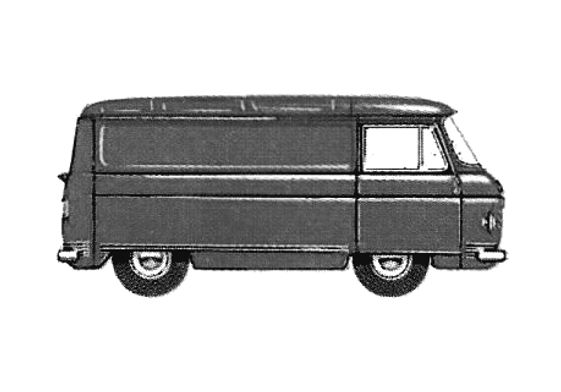
Commer FC Van 1968
- jpg
Specifications Commer FC Van 1968 blueprint
Commer was best known as a manufacturer of vans for the British Post Office, especially with the Commer FC-PA, which was presented in many body styles in 1960. This was also originally available as a panel van and minibus with a 1500 cc petrol engine. With revisions, the Commer FC-PA in 1967 became the FC-PB and the SpaceVan in 1974. Until 1976, it was offered as Commer or Fargo. Chrysler Europe then marketed it as the Dodge Spacevan. The model range was a forward control delivery van with a narrow front lane. This was a legacy of the technical kinship with the Humber cars. Initially, only a four-cylinder gasoline engine from the Hillman Minx with a displacement of 1500 cc and a four-speed gearbox was available for the van, which was available ex works as a box van / minibus also as a flatbed truck, mobile home and chassis for bodies. The engine was later enlarged to 1600 cc. The handbrake worked on the front drum brakes. After a model revision, the series became the FC-PB in 1967 and from 1968 had a four-cylinder petrol engine with a displacement of 1725 cm. The diesel engine Perkins 4108 was now also available. The 1725 cm engine was available with a three-speed automatic transmission (BorgWarner Model 35) in the 1970s. From 1974 the four-speed gearbox was also available with overdrive. The 1974 test of a motorhome version showed a maximum speed of 70 mph (113 km / h) and an acceleration of 0-50 mph (80 km / h) in 25 seconds with the 1725 cc gasoline engine. This made the Commer FC slower than the models BMC 250 JU and BMC J4 from competitor BLMC. However, the testers felt that the van was at its absolute limit at 70 mph and recommended that readers drive a maximum of 65 mph (105 km / h). The delivery van was also less popular with fleet operators than, for example, the Bedford CA or the Ford Transit. As with the models BMC 250 JU and J4, one of the reasons for this may be the construction with the motor between the seats above the axle. This restricts access to the engine and changing the engine is time-consuming. The only way to remove the engine without the front axle was to remove the windshield and maneuver the engine through the passenger door. After Chrysler Europe got into financial difficulties, the company received financial support from the UK government. For this, the Spacevan, which was praised for its good braking behavior, good cornering and reasonable price, had to be revised in terms of performance, comfort and top speed and continued production. The revised Spacevan was introduced in 1977 as the Dodge Spacevan. Although it had basically the same mechanics, but numerous changes in shape, a new interior, a new dashboard and offered more driving comfort through better insulation of the body and engine insulation. The 1.7 liter gasoline engine now offered 37 kW (with low compression) or 42 kW (with high compression), while the diesel engine produced 31 kW. After Chrysler Europe was sold to PSA in 1978, the new owner decided to discontinue the model range and introduce a model from the PSA group. But after new orders with the Post Office telephone were received, this opinion changed. The Post Office was almost entirely responsible for ensuring that the outdated Spacevan was in production for so long. British Telecom, founded in October 1981, took on the purchase obligation, so that the last Spacevan was built in 1983 and remained a familiar sight in the United Kingdom in the 1980s, at a time when all former competing models have long been replaced by successors and are out of the ordinary disappeared. In 1984 PSA then introduced the Peugeot J5, developed together with Fiat, exclusively in the United Kingdom under the name Talbot Express as the successor. On our website you can download a drawing of Commer FC Van 1968 in pdf svg png jpg ai eps formats Use it for 3d modelling different illustrations typography engineering and design projects All our drawings are made in high quality therefore they can be very helpful in your work study or research.

Careful measurement of the actual dimensions of the models, when creating their sketches, guarantees the high accuracy of our drawings, which is at the level of 94% - 99%.

When creating working drawings, all proportions of the depicted objects are strictly maintained.

You no longer need to create individual drawings of parts from scratch. The required changes to existing works are easily made using graphic editors.

The copyright holder permits the use of ready-made drawings, acquired under a free license, in the development of projects, scientific works and the preparation of presentations.


